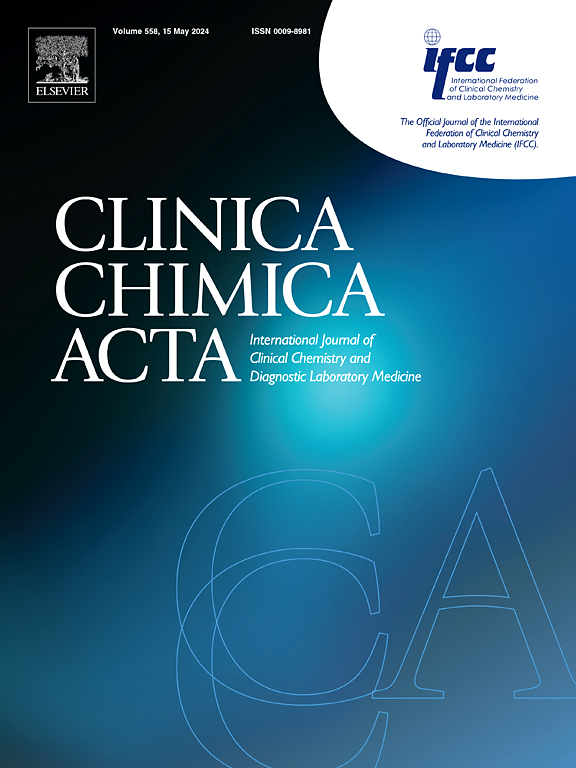Elevated neurofilament light chain associated with cobalt/chromium metal neurotoxicity in a patient with a failed hip implant
IF 3.2
3区 医学
Q2 MEDICAL LABORATORY TECHNOLOGY
引用次数: 0
Abstract
Background
It is known that the heavy metals cobalt and chromium are associated with neurotoxicity. Chromium (Cr) and Cobalt (Co) are both components of metal-on-metal (MoM) implants which can be degraded/fragmented and released into the bloodstream. Neurofilament Light Chain (NfL) is a neuron-specific protein that increases in serum following axonal damage. Here, we report a novel case of a patient with neurotoxic concentrations of serum Co and Cr stemming from fragments of a Metal on Metal (MoM) hip implant exhibiting elevated serum NfL concentrations.
Case presentation
A 56-year-old female patient with ceramic and metal fragments left in her body after hip arthroplasty revision presented with symptoms consistent with Co/Cr neurotoxicity. Serum Co, Cr and NfL concentrations were measured to assess metal ion exposure and its potential link to her neurological symptoms. Over four months following two revision surgeries, her serum Co and Cr concentrations decreased significantly from their peak levels, along with a concomitant decrease in NfL concentrations. During this period, the patient’s pathological neurological symptoms gradually resolved, with serum Co, Cr, and NfL concentrations approaching normal ranges.
Conclusion
Serum NfL is elevated in a patient exhibiting neurotoxicity from Co/Cr implant exposure. The potential utility of serum NfL as a biomarker for metal associated neurotoxicity should be further explored.
髋关节置换术失败患者神经丝轻链升高与钴/铬金属神经毒性相关
背景:众所周知,重金属钴和铬与神经毒性有关。铬(Cr)和钴(Co)都是金属对金属(MoM)植入物的成分,它们可以降解/破碎并释放到血液中。神经丝轻链(NfL)是一种神经元特异性蛋白,在轴突损伤后血清中增加。在这里,我们报告了一例新的病例,患者血清Co和Cr的神经毒性浓度源于金属对金属(MoM)髋关节植入物的碎片,显示血清NfL浓度升高。病例介绍:一名56岁女性患者,髋关节置换术后体内残留陶瓷和金属碎片,其症状与Co/Cr神经毒性一致。测定了血清Co、Cr和NfL浓度,以评估金属离子暴露及其与神经症状的潜在联系。在两次翻修手术后的四个多月里,她的血清Co和Cr浓度从峰值水平显著下降,同时NfL浓度也随之下降。在此期间,患者病理性神经症状逐渐缓解,血清Co、Cr、NfL浓度接近正常范围。结论:在Co/Cr植入物暴露的神经毒性患者中,血清NfL升高,血清NfL作为金属相关神经毒性的潜在生物标志物的潜在效用有待进一步探索。
本文章由计算机程序翻译,如有差异,请以英文原文为准。
求助全文
约1分钟内获得全文
求助全文
来源期刊

Clinica Chimica Acta
医学-医学实验技术
CiteScore
10.10
自引率
2.00%
发文量
1268
审稿时长
23 days
期刊介绍:
The Official Journal of the International Federation of Clinical Chemistry and Laboratory Medicine (IFCC)
Clinica Chimica Acta is a high-quality journal which publishes original Research Communications in the field of clinical chemistry and laboratory medicine, defined as the diagnostic application of chemistry, biochemistry, immunochemistry, biochemical aspects of hematology, toxicology, and molecular biology to the study of human disease in body fluids and cells.
The objective of the journal is to publish novel information leading to a better understanding of biological mechanisms of human diseases, their prevention, diagnosis, and patient management. Reports of an applied clinical character are also welcome. Papers concerned with normal metabolic processes or with constituents of normal cells or body fluids, such as reports of experimental or clinical studies in animals, are only considered when they are clearly and directly relevant to human disease. Evaluation of commercial products have a low priority for publication, unless they are novel or represent a technological breakthrough. Studies dealing with effects of drugs and natural products and studies dealing with the redox status in various diseases are not within the journal''s scope. Development and evaluation of novel analytical methodologies where applicable to diagnostic clinical chemistry and laboratory medicine, including point-of-care testing, and topics on laboratory management and informatics will also be considered. Studies focused on emerging diagnostic technologies and (big) data analysis procedures including digitalization, mobile Health, and artificial Intelligence applied to Laboratory Medicine are also of interest.
 求助内容:
求助内容: 应助结果提醒方式:
应助结果提醒方式:


